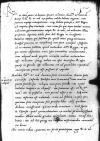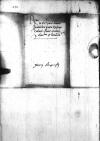Accepi litteras Reverendisssimae Dominationis Vestrae, ex quibus valde lubens cognovi eam futuris nuptiis[1] interfuturam neque dubito, quin sit a Sigismund I Jagiellon (Zygmunt I) (*1467 – †1548), King of Poland and Grand Duke of Lithuania (1506-1548); Duke of Głogów (Glogau) (1499-1506), Duke of Opava (1501-1506), Governor of Silesia (1504-1506); son of King Kazimierz IV Jagiellon and Elisabeth of Austria⌊maiestate regiaSigismund I Jagiellon (Zygmunt I) (*1467 – †1548), King of Poland and Grand Duke of Lithuania (1506-1548); Duke of Głogów (Glogau) (1499-1506), Duke of Opava (1501-1506), Governor of Silesia (1504-1506); son of King Kazimierz IV Jagiellon and Elisabeth of Austria⌋ ad nuptias istas invitata, cum nemo sit, qui aeque teneat morem aularum Germanicarum atque Reverendissima Dominatio Vestra, ut videatur illius praesentia imprimis utilis fore maiestati regiae ac necessaria.
Demiror autem, qui factum sit, quod ceteri quoque Royal Prussia (Prussia Regalis), region, part of Prussia annexed to the Kingdom of Poland in 1466 under the provisions of the Second Peace of Thorn⌊terrarum PrussiaeRoyal Prussia (Prussia Regalis), region, part of Prussia annexed to the Kingdom of Poland in 1466 under the provisions of the Second Peace of Thorn⌋ proceres et consiliarii non sunt accersiti, suspicor id ea ratione factum, quod metuebat Sigismund I Jagiellon (Zygmunt I) (*1467 – †1548), King of Poland and Grand Duke of Lithuania (1506-1548); Duke of Głogów (Glogau) (1499-1506), Duke of Opava (1501-1506), Governor of Silesia (1504-1506); son of King Kazimierz IV Jagiellon and Elisabeth of Austria⌊maiestas regiaSigismund I Jagiellon (Zygmunt I) (*1467 – †1548), King of Poland and Grand Duke of Lithuania (1506-1548); Duke of Głogów (Glogau) (1499-1506), Duke of Opava (1501-1506), Governor of Silesia (1504-1506); son of King Kazimierz IV Jagiellon and Elisabeth of Austria⌋, ne qui per eorum absentiam novi istic tumultus concitarentur, cum aliquid mali propter vicinum malum metuendum esse videatur. Itaque voluit eos istic Sigismund I Jagiellon (Zygmunt I) (*1467 – †1548), King of Poland and Grand Duke of Lithuania (1506-1548); Duke of Głogów (Glogau) (1499-1506), Duke of Opava (1501-1506), Governor of Silesia (1504-1506); son of King Kazimierz IV Jagiellon and Elisabeth of Austria⌊maiestas regiaSigismund I Jagiellon (Zygmunt I) (*1467 – †1548), King of Poland and Grand Duke of Lithuania (1506-1548); Duke of Głogów (Glogau) (1499-1506), Duke of Opava (1501-1506), Governor of Silesia (1504-1506); son of King Kazimierz IV Jagiellon and Elisabeth of Austria⌋ quasi in specula esse collocatos, ut ad quamlibet repentinam incursionem parati esse possent et expediti.
Habebit Reverendissima Dominatio Vestra domum satis commodam domini Piotr Konarski (†1536), nephew of Cracow bishop Jan Konarski; 1513 Cracow Canon; 1516 Provost at the collegiate chapter in Kielce; 1519 - in Raciborz; 1517 Cracow Custos; parish priest in Proszowice (POCIECHA 2, p. 15, 472; Artes, p. 18)⌊Petri ConarskiPiotr Konarski (†1536), nephew of Cracow bishop Jan Konarski; 1513 Cracow Canon; 1516 Provost at the collegiate chapter in Kielce; 1519 - in Raciborz; 1517 Cracow Custos; parish priest in Proszowice (POCIECHA 2, p. 15, 472; Artes, p. 18)⌋ custodis ecclesiae meae Cracoviensis, in quam se recipiet on the margin⌈in quam se recipietin quam se recipiet on the margin⌉ cum maiore parte familiae suae, reliqua vero pars familiae cum equis habebit hospitia in Kleparz (Cleparz, Clepardia), town near Cracow, today part of Cracow⌊CleparzKleparz (Cleparz, Clepardia), town near Cracow, today part of Cracow⌋; ita futurum est, ut Reverendissima Dominatio Vestra, ita ut postulat, non procul absit a me. Sed mea nunc infirma est valetudo, nam ad febrem, a qua sesquianno fere numquam fui prorsus liber, alii quidam dolores accesserunt, qui me male cruciant. Sed spero in Christo, quod quemadmodum ex multis periculosissimis morbis, illius mihi gratia opitulante, antea evasi incolumis, ita ab his quoque me eiusdem misericordia recreatum iri brevi.
De novis rebus, quarum me fecit participem, ago Reverendissimae Dominationi Vestrae
 BCz, 247, p. 246
gratias et eam in multos annos incolumem esse cupio, meque mutuo illius amori commendo.
BCz, 247, p. 246
gratias et eam in multos annos incolumem esse cupio, meque mutuo illius amori commendo.
 BCz, 247, p. 246
gratias et eam in multos annos incolumem esse cupio, meque mutuo illius amori commendo.
BCz, 247, p. 246
gratias et eam in multos annos incolumem esse cupio, meque mutuo illius amori commendo.


